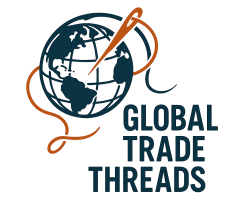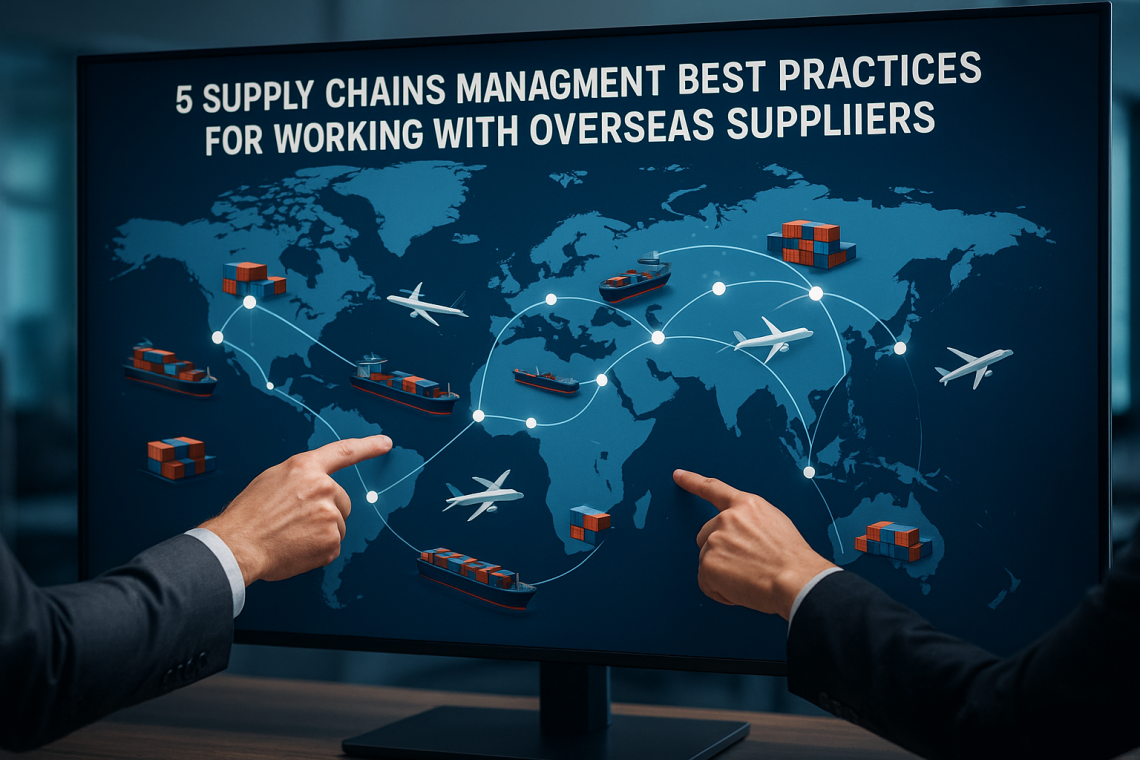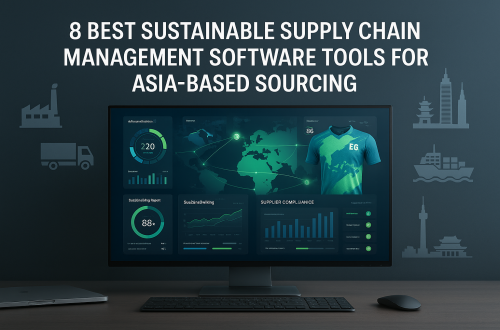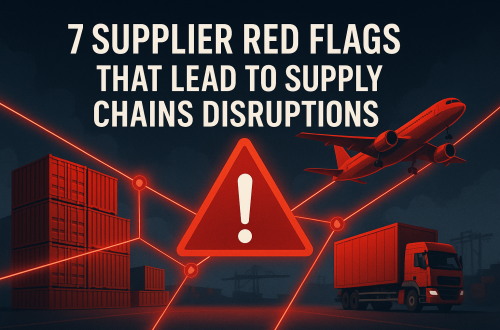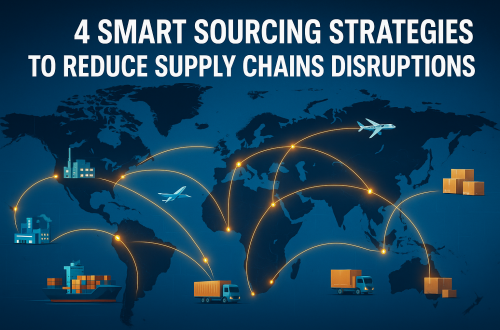When you work with suppliers around the globe, you have an opportunity to tap into manufacturing strengths, cost-effective production, and diverse markets. However, these benefits come with their fair share of challenges, making supply chains management even more critical. From language barriers to logistical hiccups, overseas partnerships require a strong plan to keep production on track and maintain quality standards.
In fact, around 62% of organizations report limited visibility within their supply chains, and disruptions can cost global businesses approximately $184 billion every year. This blog post will discuss five best practices in supply chains management to help you work efficiently and successfully with overseas suppliers.
Adopting proven strategies can save you time, resources, and frustration. You will learn how to strengthen supplier relationships, conduct thorough due diligence, improve visibility, leverage technology, and create resilient contingency plans. These tips are drawn from research on global supply chain trends and insights from modern businesses.
Whether you’re a sourcing manager, e-commerce entrepreneur, or supply chain professional, implementing these ideas can improve your product delivery, reduce risks, and keep your international operations running smoothly.

Supply Chains Management Best Practice #1: Strengthen Supplier Relationships
Building and maintaining good relationships with overseas suppliers is central to effective supply chains management. While cost savings usually serve as the initial motivation for global sourcing, a focus on genuine collaboration can safeguard against future uncertainties. For instance, if you develop open communication with your suppliers, you have a better chance of receiving timely updates on delays or material shortages.
In many cases, such advanced information allows you to quickly adapt or find alternative resources. According to the Council of Supply Chain Management Professionals (CSCMP), strong mutual trust and respect can significantly reduce disruptions in delivery times and quality control.
To strengthen supplier relationships, start by scheduling regular calls or video conferences to discuss production updates, potential challenges, and market changes. Encourage your suppliers to share feedback about product designs and demand forecasts. You can also explore using collaborative supply chain management tools like Anaplan, which offers real-time planning and performance management features.
These platforms help maintain transparent communication and allow you to detect issues early. By nurturing strong partnerships, you ensure that everyone in the chain—from raw material providers to final shippers—remains committed to meeting your quality and delivery expectations.
Supply Chains Management Best Practice #2: Conduct Comprehensive Due Diligence
When sourcing from overseas, it’s essential to perform a thorough background check on potential suppliers. This step can save you considerable time and money in the long run. Reports show that 43% of organizations have dealt with significant disruptions due to supplier bankruptcy.
Before you finalize any contract, research your supplier’s financial status, production capacity, and compliance with local regulations. You may want to consult the International Trade Administration (ITA) for advice on fair trade practices, or you can review data from the World Trade Organization (WTO) to understand your supplier’s trading history.
Another due diligence strategy includes evaluating the supplier’s ethical and sustainability practices. More companies worldwide now emphasize sustainability and environmental responsibility, and you want to make sure your organization aligns with these values. Examine whether the supplier follows labor standards, uses eco-friendly materials, or invests in clean technology.
If you need deeper insights, tools like Resilinc provide real-time monitoring of supply chain risks, including financial viability and regulatory compliance. By performing comprehensive due diligence, you’re better prepared to avoid common roadblocks such as quality issues, legal troubles, and shipping bottlenecks that can hinder efficient supply chains management.

Best Practice #3: Improve Supply Chain Visibility
Visibility is critical in an era where 54% of supply chain executives consider it one of their top priorities. Businesses often deal with multiple third-party logistics providers, carriers, and warehouses, which can complicate processes and delay information flow.
For example, if you’re manufacturing promotional items in Asia for a Western market, the goods might pass through multiple checkpoints—factories, ports, and customs—before reaching distribution centers. Without real-time visibility, delays or errors might go unnoticed until it’s too late to mitigate them.
To improve visibility, companies must invest in the right tools. Software like Oracle SCM Cloud brings all your data into one platform, efficiently connecting suppliers, manufacturers, and freight forwarders. You can track shipments, forecast potential stockouts, and analyze performance metrics, all in one place.
Meanwhile, blockchain-based platforms such as TradeLens, developed by IBM and Maersk, offer greater data transparency and security by recording transactions on a tamper-proof ledger. Enhanced visibility does more than help you spot problems. It also builds trust with consumers who increasingly want to know the exact source and journey of their products.
Supply Chains Management Best Practice #4: Adopt Automation and AI Technologies
Global supply chains management is evolving rapidly, thanks to AI and automation. These innovations can reduce prediction errors by up to 50% and lower occurrences of overstocked inventory. AI plays a huge role in demand forecasting, helping you decide how much product to order from your overseas suppliers.
For example, advanced algorithms can factor in variables like seasonal trends, shipping times, and even geopolitical events. According to research, 27% of current global supply chains face disruptions due to political or economic tensions, making accurate forecasting and risk assessment more crucial.
Automation tools can also streamline repetitive tasks like invoice processing and shipment scheduling. Using platforms such as SAP Supply Chain Management or Oracle SCM Cloud can shorten lead times, reduce human error, and give you actionable insights.
Autonomous systems, like AI-driven chatbots, enable 24/7 communication between you and your suppliers, ensuring urgent matters are addressed quickly. By integrating automation and AI into your overseas sourcing strategy, you reduce delays and build a stronger, data-driven foundation for decision-making—both of which are essential for supply chains management.
Supply Chains Management Best Practice #5: Build Resilient Contingency Plans
Natural disasters and unforeseen disruptions have been rising in recent years, with 74% of companies reporting interruptions caused by events such as severe weather. Furthermore, cybersecurity threats impact 61% of global organizations. Having a strong contingency plan prevents these disruptions from crippling your supply chain. A robust risk management approach will incorporate backup suppliers, diversified shipping routes, and an emergency communications protocol.
Start by analyzing possible “what-if” scenarios, from factory closures to political conflicts, and map out your solutions in a simple, step-by-step manner. You might develop parallel sourcing strategies, where you maintain two or more suppliers for critical components.
Consider collaborating with industry groups like the Global Supply Chain Institute (GSCI) to learn about standard practices for risk mitigation. You can also talk to logistics partners like UPS or FedEx about alternate transport modes. By preparing a systematic plan, you ensure that supply chains management remains consistent, no matter what challenges emerge.
Conclusion
Supply chains management with overseas suppliers requires foresight, flexibility, and practical strategies. When you strengthen supplier relationships, conduct thorough due diligence, improve visibility, embrace AI-driven automation, and invest in contingency planning, you set a firm foundation for smooth international operations.
These best practices do more than control costs—they support a seamless flow of goods while maintaining quality and meeting delivery timelines, even amid global uncertainties.
In an environment where geopolitical, natural, and economic disruptions are increasingly common, a proactive approach to supply chains management becomes a competitive advantage. By leveraging the best tools, working with reliable logistics partners, and staying informed on industry trends, you can protect your bottom line and build stronger partnerships around the world.
Whether you’re launching a new product or scaling production, keep focusing on the essential elements of supply chains management to meet market demands and stay ahead of the competition.
